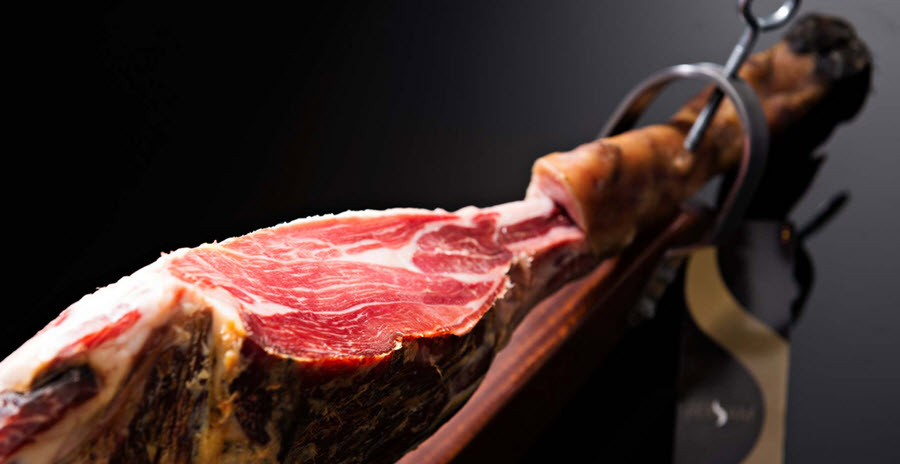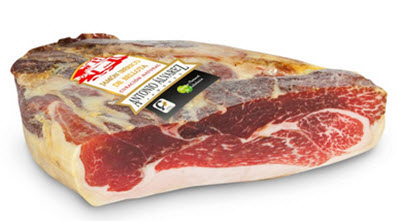
Jamón ibérico is a type of ham produced in Spain and Portugal – the two main countries on the Iberian peninsula. In Portugal, jamón ibérico is known as presunto ibérico. Both the Spanish and the Portuguese name means Iberian ham.
The jamón ibérico is renowned for its smooth texture and a rich, savory taste that develops during long-term curing. The fat content is pretty high and a good piece will sport regular flecks of intramuscular fat (marbling).
According to Spain’s rules for Denominación de Origen, jamón de ibérico must be made from black Iberian pigs or cross-bred pigs that are at least 50% black Iberian pigs.
 Buying jamón ibérico in the United States
Buying jamón ibérico in the United StatesJamón ibérico wasn’t (legally) available in the United States until 2007. Until 2005, pork products imported to the U.S. had to come from pigs raised and slaughtered outside of Spain. (Pork products processed in Spain were allowed however, as long as the raising and slaughtering took place elsewhere in an USDA approved slaughterhouse.) This situation changed in 2005, when a slaughterhouse in Spain – the Embutidos y Jamones Fermín (Salamanca) – was approved by the U.S. Department of Agriculture (USDA) to produce Iberian ham products for export to the U.S.
The first jamón ibéricos were released for sale in the United States in December 2007.
Jamón ibérico is still considered somewhat of an oddity in the United States and is typically sought after by people with a serious interest in Spanish hams and the ability to pay well for high-quality products. You can find jamón ibérico in well-assorted delis and also in some well-stocked supermarkets. It is also a popular item in speciality shops devoted to Spanish or Southern European food, or to imported delicacy meats from around the world.
If you are looking for a less expensive alternative to jamón ibérico, we recommend a high-quality jamón serrano. This Spanish dry-cured ham can come from several types of pigs, not just the black Iberian pig, and this helps keep down the price a bit. Compared to the jamón ibérico, it tend to have a lower fat content.
Jamón ibérico is made from black Iberian pigs. In Spain, a majority of these pigs live in the following provinces:
Once weaned, the piglets are put on a diet rich in barley and maize to grow fat. They are also allowed to roam around in pasture land and oak groves where they can find a rich assortment of naturally occurring food to supplement the barley and maize with, such as acorns, herbs and roots.
As slaughtering time grows near, the diet may be strictly limited to olives or acorns to produce the very best jamón ibérico. For lower quality jamón ibérico, a less expensive diet consisting of acorns + commercial pig feed is common.
| Jamón ibérico de bellota | This is the most sought after and most costly of all the jamon ibericos, and they are cured for 36 months.
Bellota means acorn, and this type of ham hails from pigs that roam oak forests (dehesas). The combination of natural exercise and a diet rich in acorns has a very positive impact on the flavour of the ham. According to Spanish law, this is the only kind of jamón ibérico that is allowed to have pictures of acorns and/or dehesas on labels and packaging. There are two types of jamón ibérico de bellota:
|
| Jamón ibérico cebo de campo | This ham comes from pigs that are pastured and fed a combination of acorns and grains. The Jamón ibérico cebo de campo label is green. |
| Jamón ibérico de cebo | This ham comes from pigs that are feed only grain, no acorns. The ham is cured for 24 months. The label is white.
Some producers mark this ham with “Jamón ibérico” only. |
According to Spanish law, the word puro (which means pure) may only be added to the labelling if both the father and the mother of the slaughtered pig were pure Iberian pigs and correctly registered as such in the pedigree books held by official breeders.
According to the new Spanish labelling system, implemented in 2014, jamón ibérico can only come from the hind legs of pigs. The front legs are known as paleta instead, and loin cuts should be marked caña de lomo.
Pata negra is Spanish for “black paw” and is sometimes used as short-hand for jamón ibérico regardless of classification. It is a reference to the black nails of the black Ibero pigs.
Black nails still left on a pig leg when sold is seen as proof of the pig being a real black Iberian pig, but some fraudsters will paint the nails of other pig breeds black to pass them off as the real deal.